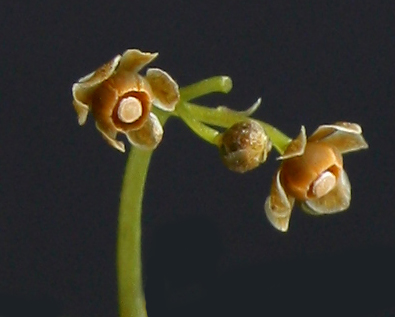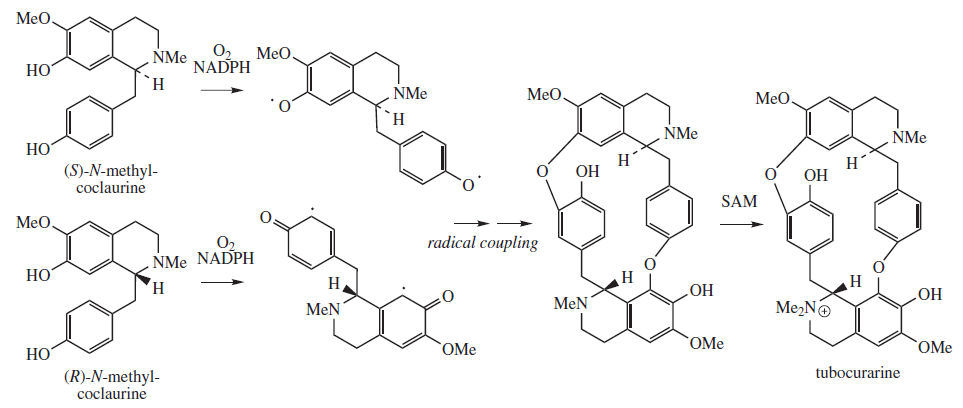|
Menispermaceae
Menispermaceae (botanical Latin: 'moonseed family' from Greek ''mene'' 'crescent moon' and ''sperma'' 'seed') is a family of flowering plants. The alkaloid tubocurarine, a neuromuscular blocker and the active ingredient in the 'tube curare' form of the dart poison curare, is derived from the South American liana ''Chondrodendron tomentosum''. Several other South American genera belonging to the family have been used to prepare the 'pot' and 'calabash' forms of curare. The family contains 68 genera with some 440 species, which are distributed throughout low-lying tropical areas with some species present in temperate and arid regions. Description * Twining woody climbing plants, winding anti-clockwise (''Stephania'' winds clockwise) or vines, rarely upright shrubs or small trees, more rarely still herbaceous plants or epiphytes (''Stephania cyanantha''), perennial or deciduous, with simple to uni-serrate hairs. * Alternate spiral leaves, simple, whole, dentate, lobed to palmatifi ... [...More Info...] [...Related Items...] OR: [Wikipedia] [Google] [Baidu] |
Curare
Curare ( /kʊˈrɑːri/ or /kjʊˈrɑːri/; ''koo-rah-ree'' or ''kyoo-rah-ree'') is a common name for various alkaloid arrow poisons originating from plant extracts. Used as a paralyzing agent by indigenous peoples in Central and South America for hunting and for therapeutic purposes, curare only becomes active when it contaminates a wound. These poisons cause weakness of the skeletal muscles and, when administered in a sufficient dose, eventual death by asphyxiation due to paralysis of the diaphragm. Curare is prepared by boiling the bark of one of the dozens of plant sources, leaving a dark, heavy paste that can be applied to arrow or dart heads. In medicine, curare has been used as a treatment for tetanus or strychnine poisoning and as a paralyzing agent for surgical procedures. History The word 'curare' is derived from ''wurari'', from the Carib language of the Macusi of Guyana. It has its origins in the Carib phrase "mawa cure" meaning of the Mawa vine, scien ... [...More Info...] [...Related Items...] OR: [Wikipedia] [Google] [Baidu] |
Stephania
''Stephania'' is a genus of flowering plants in the family Menispermaceae, native to eastern and southern Asia and Australia. They are herbaceous perennial vines, growing to around four metres tall, with a large tuber. The leaves are arranged spirally on the stem and are peltate, with the leaf petiole attached near the centre of the leaf. The name ''Stephania'' comes from the Greek, "a crown". This refers to the anthers being arranged in a crown-like manner. One species, '' S. tetrandra'', is among the 50 fundamental herbs used in traditional Chinese medicine, where it is called ''han fang ji'' (漢防己, "Chinese ''fang ji''"). Other plants named ''fang ji'' are sometimes substituted for it. Other varieties substituted include '' Cocculus thunbergii'', '' C. trulobus'', ''Aristolochia fangchi'', '' Stephania tetrandria'', and ''Sinomenium acutum''. Notable among these is ''guang fang ji'' (廣防己, "(GuangDong, GuangXi) fang ji", ''Aristolochia fangchi''. Because of its tox ... [...More Info...] [...Related Items...] OR: [Wikipedia] [Google] [Baidu] |
Antizoma
''Antizoma'' is a genus of flowering plants belonging to the family Menispermaceae Menispermaceae (botanical Latin: 'moonseed family' from Greek ''mene'' 'crescent moon' and ''sperma'' 'seed') is a family of flowering plants. The alkaloid tubocurarine, a neuromuscular blocker and the active ingredient in the 'tube curare' form .... Its native range is Angola to Southern Africa. Species: *''Antizoma angolensis'' *''Antizoma angustifolia'' *''Antizoma miersiana'' References {{Taxonbar, from=Q8200990 Menispermaceae Menispermaceae genera ... [...More Info...] [...Related Items...] OR: [Wikipedia] [Google] [Baidu] |
Chondrodendron Tomentosum
''Chondrodendron tomentosum'' is one of six accepted species in the small genus Chondrodendron, belonging to the Moonseed family Menispermaceae. It is a large tropical liana native to Central and South America.It contains highly toxic alkaloids and is one of the sources of the arrow poison curare - specifically 'tube curare', the name of which is derived from the name of the medicinally valuable alkaloid tubocurarine Tubocurarine (also known as ''d''-tubocurarine or DTC) is a toxic alkaloid historically known for its use as an arrow poison. In the mid-1900s, it was used in conjunction with an anesthetic to provide skeletal muscle relaxation during surgery or .... Derivation of scientific name The generic name is a compound of Greek χόνδρος ( chondros ) 'cartilage' / 'lump' / 'grain' and δένδρον ( dendron ) 'tree' - hence 'lumpy / gristly tree', while the specific name consists of the Latin adjectival form ''tomentosum'' 'covered in matted hairs'. The binomial in ... [...More Info...] [...Related Items...] OR: [Wikipedia] [Google] [Baidu] |
Burasaia
''Burasaia'' is a genus of flowering plants belonging to the family Menispermaceae Menispermaceae (botanical Latin: 'moonseed family' from Greek ''mene'' 'crescent moon' and ''sperma'' 'seed') is a family of flowering plants. The alkaloid tubocurarine, a neuromuscular blocker and the active ingredient in the 'tube curare' form .... Its native range is Madagascar. Species: *'' Burasaia australis'' *'' Burasaia congesta'' *'' Burasaia gracilis'' *'' Burasaia madagascariensis'' References {{Taxonbar, from=Q8253662 Menispermaceae Menispermaceae genera ... [...More Info...] [...Related Items...] OR: [Wikipedia] [Google] [Baidu] |
Menispermum Canadense
''Menispermum canadense'', the Canadian moonseed, common moonseed, or yellow parilla, is a flowering plant in the family Menispermaceae, native to eastern North America, from southern Canada south to northern Florida, and from the Atlantic coast west to Manitoba and Texas. It occurs in thickets, moist woods, and the banks of streams. Description It is a woody climbing vine growing to tall. The leaves are palmately lobed, in diameter with 3–7 shallow lobes, occasionally rounded and unlobed. The fruit are produced in diameter clusters of purple-black berries, each berry is 1–1.5 cm in diameter. The seed inside the berry resembles a crescent moon, and is responsible for the common name. The fruit is ripe between September and October, the same general time frame in which wild grapes are ripe. Both the leaves and fruit resemble those of grapes; confusion can be dangerous as moonseed fruit is poisonous. The root is a rhizome, so one specimen can form colonies of gen ... [...More Info...] [...Related Items...] OR: [Wikipedia] [Google] [Baidu] |
Anamirta
''Anamirta'' is a genus of woody vines, native to southern Asia. Species *''Anamirta cocculus ''Anamirta cocculus'' ( mr, काकमारी) is a Southeast Asian and Indian climbing plant. Its fruit is the source of picrotoxin, a poisonous compound with stimulant properties. The plant is large-stemmed (up to 10 cm in diameter) ...'' *'' Anamirta jucunda'' Miers (Java) *'' Anamirta lemniscata'' Miers (Java) *'' Anamirta lourieri'' Pierre (Cambodia) *'' Anamirta luctuosa'' Miers (Java) *'' Anamirta paniculata'' (East Asia) *'' Anamirta populifera'' Miers (Timor) *'' Anamirta pfeiffer'' (Status : fossil) References Menispermaceae genera Menispermaceae {{Ranunculales-stub ... [...More Info...] [...Related Items...] OR: [Wikipedia] [Google] [Baidu] |
Tubocurarine
Tubocurarine (also known as ''d''-tubocurarine or DTC) is a toxic alkaloid historically known for its use as an arrow poison. In the mid-1900s, it was used in conjunction with an anesthetic to provide skeletal muscle relaxation during surgery or mechanical ventilation. It is now rarely used as an adjunct for clinical anesthesia because safer alternatives, such as cisatracurium and rocuronium, are available. History Tubocurarine is a naturally occurring mono-quaternary alkaloid obtained from the bark of the Menispermaceous South American plant '' Chondrodendron tomentosum'', a climbing vine known to the European world since the Spanish conquest of South America. Curare had been used as a source of arrow poison by South American natives to hunt animals, and they were able to eat the animals' contaminated flesh subsequently without any adverse effects because tubocurarine cannot easily cross mucous membranes. Thus, tubocurarine is effective only if given parenterally, as demons ... [...More Info...] [...Related Items...] OR: [Wikipedia] [Google] [Baidu] |
Leaf
A leaf ( : leaves) is any of the principal appendages of a vascular plant stem, usually borne laterally aboveground and specialized for photosynthesis. Leaves are collectively called foliage, as in "autumn foliage", while the leaves, stem, flower, and fruit collectively form the shoot system. In most leaves, the primary photosynthetic tissue is the palisade mesophyll and is located on the upper side of the blade or lamina of the leaf but in some species, including the mature foliage of ''Eucalyptus'', palisade mesophyll is present on both sides and the leaves are said to be isobilateral. Most leaves are flattened and have distinct upper (adaxial) and lower ( abaxial) surfaces that differ in color, hairiness, the number of stomata (pores that intake and output gases), the amount and structure of epicuticular wax and other features. Leaves are mostly green in color due to the presence of a compound called chlorophyll that is essential for photosynthesis as it absorbs light ... [...More Info...] [...Related Items...] OR: [Wikipedia] [Google] [Baidu] |
Leaf
A leaf ( : leaves) is any of the principal appendages of a vascular plant stem, usually borne laterally aboveground and specialized for photosynthesis. Leaves are collectively called foliage, as in "autumn foliage", while the leaves, stem, flower, and fruit collectively form the shoot system. In most leaves, the primary photosynthetic tissue is the palisade mesophyll and is located on the upper side of the blade or lamina of the leaf but in some species, including the mature foliage of ''Eucalyptus'', palisade mesophyll is present on both sides and the leaves are said to be isobilateral. Most leaves are flattened and have distinct upper (adaxial) and lower ( abaxial) surfaces that differ in color, hairiness, the number of stomata (pores that intake and output gases), the amount and structure of epicuticular wax and other features. Leaves are mostly green in color due to the presence of a compound called chlorophyll that is essential for photosynthesis as it absorbs light ... [...More Info...] [...Related Items...] OR: [Wikipedia] [Google] [Baidu] |
Species
In biology, a species is the basic unit of classification and a taxonomic rank of an organism, as well as a unit of biodiversity. A species is often defined as the largest group of organisms in which any two individuals of the appropriate sexes or mating types can produce fertile offspring, typically by sexual reproduction. Other ways of defining species include their karyotype, DNA sequence, morphology, behaviour or ecological niche. In addition, paleontologists use the concept of the chronospecies since fossil reproduction cannot be examined. The most recent rigorous estimate for the total number of species of eukaryotes is between 8 and 8.7 million. However, only about 14% of these had been described by 2011. All species (except viruses) are given a two-part name, a "binomial". The first part of a binomial is the genus to which the species belongs. The second part is called the specific name or the specific epithet (in botanical nomenclature, also sometimes i ... [...More Info...] [...Related Items...] OR: [Wikipedia] [Google] [Baidu] |
Family (biology)
Family ( la, familia, plural ') is one of the eight major hierarchical taxonomic ranks in Linnaean taxonomy. It is classified between order and genus. A family may be divided into subfamilies, which are intermediate ranks between the ranks of family and genus. The official family names are Latin in origin; however, popular names are often used: for example, walnut trees and hickory trees belong to the family Juglandaceae, but that family is commonly referred to as the "walnut family". What belongs to a family—or if a described family should be recognized at all—are proposed and determined by practicing taxonomists. There are no hard rules for describing or recognizing a family, but in plants, they can be characterized on the basis of both vegetative and reproductive features of plant species. Taxonomists often take different positions about descriptions, and there may be no broad consensus across the scientific community for some time. The publishing of new data and opin ... [...More Info...] [...Related Items...] OR: [Wikipedia] [Google] [Baidu] |



.png)
